Childhood Obesity in Australia: Inequity between Indigenous and Non-Indigenous Australians
VerifiedAdded on 2022/12/20
|8
|2232
|5
AI Summary
This article discusses the reasons for inequity in childhood obesity between Indigenous and non-Indigenous Australians, focusing on inadequate fruit intake and low education levels. It also explores the impact of a primary health care intervention and the role of cultural knowledge and sensitivity in improving access to health care services.
Contribute Materials
Your contribution can guide someone’s learning journey. Share your
documents today.

Health and Society
Assessment 3
Extended ResponseTemplate
Using you health issue from assessment item 2:
Topic : childhood obesity in Australia.
Answer all of the three questions below based upon this one health issue.
Childhood obesity in Australia
Each extended response should be approximately 500 words in length each.
The reference list for all three extended response should be provided under the references heading
of this template.
Assessment 3
Extended ResponseTemplate
Using you health issue from assessment item 2:
Topic : childhood obesity in Australia.
Answer all of the three questions below based upon this one health issue.
Childhood obesity in Australia
Each extended response should be approximately 500 words in length each.
The reference list for all three extended response should be provided under the references heading
of this template.
Secure Best Marks with AI Grader
Need help grading? Try our AI Grader for instant feedback on your assignments.
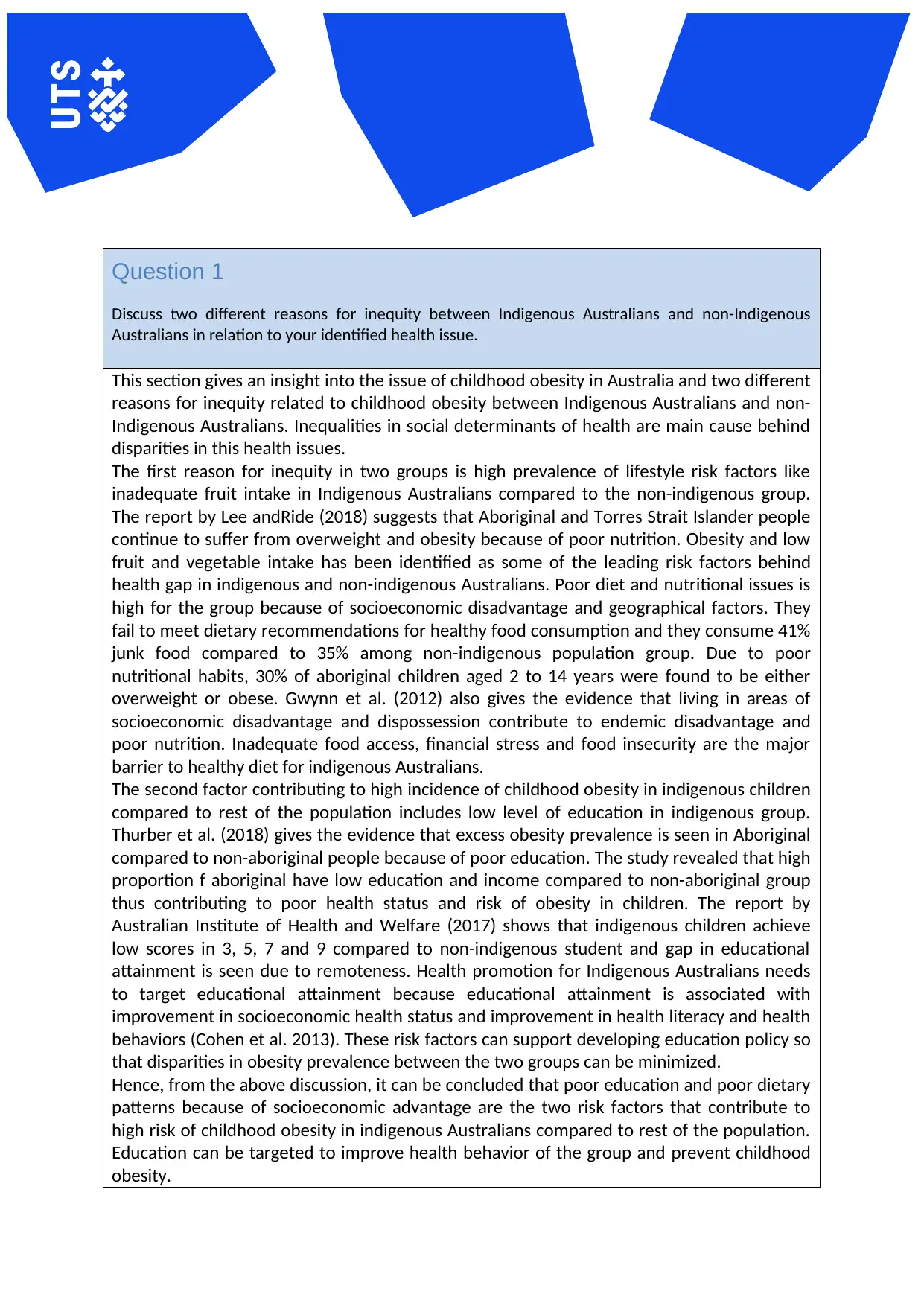
Question 1
Discuss two different reasons for inequity between Indigenous Australians and non-Indigenous
Australians in relation to your identified health issue.
This section gives an insight into the issue of childhood obesity in Australia and two different
reasons for inequity related to childhood obesity between Indigenous Australians and non-
Indigenous Australians. Inequalities in social determinants of health are main cause behind
disparities in this health issues.
The first reason for inequity in two groups is high prevalence of lifestyle risk factors like
inadequate fruit intake in Indigenous Australians compared to the non-indigenous group.
The report by Lee andRide (2018) suggests that Aboriginal and Torres Strait Islander people
continue to suffer from overweight and obesity because of poor nutrition. Obesity and low
fruit and vegetable intake has been identified as some of the leading risk factors behind
health gap in indigenous and non-indigenous Australians. Poor diet and nutritional issues is
high for the group because of socioeconomic disadvantage and geographical factors. They
fail to meet dietary recommendations for healthy food consumption and they consume 41%
junk food compared to 35% among non-indigenous population group. Due to poor
nutritional habits, 30% of aboriginal children aged 2 to 14 years were found to be either
overweight or obese. Gwynn et al. (2012) also gives the evidence that living in areas of
socioeconomic disadvantage and dispossession contribute to endemic disadvantage and
poor nutrition. Inadequate food access, financial stress and food insecurity are the major
barrier to healthy diet for indigenous Australians.
The second factor contributing to high incidence of childhood obesity in indigenous children
compared to rest of the population includes low level of education in indigenous group.
Thurber et al. (2018) gives the evidence that excess obesity prevalence is seen in Aboriginal
compared to non-aboriginal people because of poor education. The study revealed that high
proportion f aboriginal have low education and income compared to non-aboriginal group
thus contributing to poor health status and risk of obesity in children. The report by
Australian Institute of Health and Welfare (2017) shows that indigenous children achieve
low scores in 3, 5, 7 and 9 compared to non-indigenous student and gap in educational
attainment is seen due to remoteness. Health promotion for Indigenous Australians needs
to target educational attainment because educational attainment is associated with
improvement in socioeconomic health status and improvement in health literacy and health
behaviors (Cohen et al. 2013). These risk factors can support developing education policy so
that disparities in obesity prevalence between the two groups can be minimized.
Hence, from the above discussion, it can be concluded that poor education and poor dietary
patterns because of socioeconomic advantage are the two risk factors that contribute to
high risk of childhood obesity in indigenous Australians compared to rest of the population.
Education can be targeted to improve health behavior of the group and prevent childhood
obesity.
Discuss two different reasons for inequity between Indigenous Australians and non-Indigenous
Australians in relation to your identified health issue.
This section gives an insight into the issue of childhood obesity in Australia and two different
reasons for inequity related to childhood obesity between Indigenous Australians and non-
Indigenous Australians. Inequalities in social determinants of health are main cause behind
disparities in this health issues.
The first reason for inequity in two groups is high prevalence of lifestyle risk factors like
inadequate fruit intake in Indigenous Australians compared to the non-indigenous group.
The report by Lee andRide (2018) suggests that Aboriginal and Torres Strait Islander people
continue to suffer from overweight and obesity because of poor nutrition. Obesity and low
fruit and vegetable intake has been identified as some of the leading risk factors behind
health gap in indigenous and non-indigenous Australians. Poor diet and nutritional issues is
high for the group because of socioeconomic disadvantage and geographical factors. They
fail to meet dietary recommendations for healthy food consumption and they consume 41%
junk food compared to 35% among non-indigenous population group. Due to poor
nutritional habits, 30% of aboriginal children aged 2 to 14 years were found to be either
overweight or obese. Gwynn et al. (2012) also gives the evidence that living in areas of
socioeconomic disadvantage and dispossession contribute to endemic disadvantage and
poor nutrition. Inadequate food access, financial stress and food insecurity are the major
barrier to healthy diet for indigenous Australians.
The second factor contributing to high incidence of childhood obesity in indigenous children
compared to rest of the population includes low level of education in indigenous group.
Thurber et al. (2018) gives the evidence that excess obesity prevalence is seen in Aboriginal
compared to non-aboriginal people because of poor education. The study revealed that high
proportion f aboriginal have low education and income compared to non-aboriginal group
thus contributing to poor health status and risk of obesity in children. The report by
Australian Institute of Health and Welfare (2017) shows that indigenous children achieve
low scores in 3, 5, 7 and 9 compared to non-indigenous student and gap in educational
attainment is seen due to remoteness. Health promotion for Indigenous Australians needs
to target educational attainment because educational attainment is associated with
improvement in socioeconomic health status and improvement in health literacy and health
behaviors (Cohen et al. 2013). These risk factors can support developing education policy so
that disparities in obesity prevalence between the two groups can be minimized.
Hence, from the above discussion, it can be concluded that poor education and poor dietary
patterns because of socioeconomic advantage are the two risk factors that contribute to
high risk of childhood obesity in indigenous Australians compared to rest of the population.
Education can be targeted to improve health behavior of the group and prevent childhood
obesity.
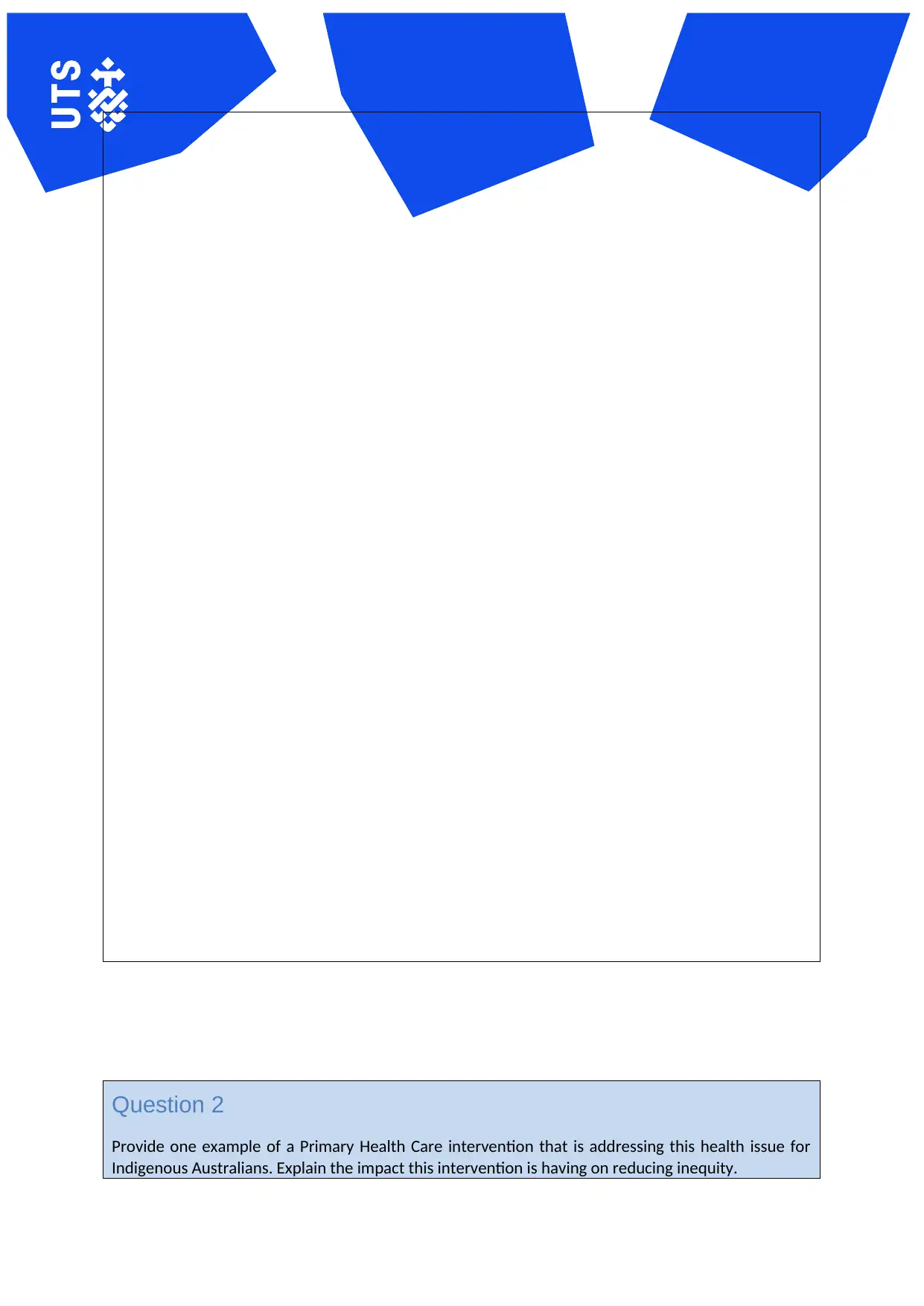
Question 2
Provide one example of a Primary Health Care intervention that is addressing this health issue for
Indigenous Australians. Explain the impact this intervention is having on reducing inequity.
Provide one example of a Primary Health Care intervention that is addressing this health issue for
Indigenous Australians. Explain the impact this intervention is having on reducing inequity.

This section discusses about one primary health care intervention to address childhood
obesity for indigenous Australians and evaluate the impact of this intervention in reducing
inequity.
The implementation of nutritional promotion project or nutritional intervention is one such
example that is aiming to reduce risk of poor nutrition in indigenous Australians. This is
understood from the Healthy Start campaign which focused on the closing the gap on
indigenous childhood obesity by implementing nutritional projects that target poor growth
and excess weight in young children. Aboriginal children are more likely to skip breakfast
and they are more likely to drink one glass of cold drinks every day. They also spend lot of
time in front of television. Hence, nutritional intervention can address lower intake of fruit
and vegetables in the group and support children to meet dietary guidelines for healthy
food intake. Some example of successful nutritional intervention implemented in Australia
includes implementation of primary school based program that improve nutrition and
knowledge and children’s preference for healthier food choices (NSW Government 2017).
Nyberg et al. (2016) gives the evidence parent support programmes are effective in
promoting health behaviors and preventing obesity in children. By evaluating the
effectiveness of such program for six year old children in disadvantaged area, the study
revealed some significant intervention effects such as reduction in unhealthy food and
unhealthy drinks. Hence, interventions implemented in school can reduce inequity and
prevent obesity in indigenous children living in disadvantaged areas.
There are many research evidences that support the effectiveness of dietary intervention in
reducing inequity in this area for indigenous Australians. Schembri et al. (2016) gives the
evidence that nutritional education is an effective strategy in addressing poor nutritional
intake. Nutrition has become a focus of several health interventions for Aboriginal people
and the systematic review of the impact of nutrition education on diet related outcome of
the group result in improvement in health outcomes. This evidence suggests that nutrition
education can address health issues in relation to obesity for Indigenous Australians.
Hence, from the above discussion, it can be concluded that nutritional programs or school
based nutritional education programs are effective intervention to improve health of obese
indigenous children. This intervention can improve dietary pattern and healthy behaviors
thus minimizing gaps in obesity outcomes for indigenous Australians. It will favor
implementation of more nutrition education program for at risk families so that indigenous
parents become aware about risk factors of childhood obesity and improve dietary patterns
of their children.
obesity for indigenous Australians and evaluate the impact of this intervention in reducing
inequity.
The implementation of nutritional promotion project or nutritional intervention is one such
example that is aiming to reduce risk of poor nutrition in indigenous Australians. This is
understood from the Healthy Start campaign which focused on the closing the gap on
indigenous childhood obesity by implementing nutritional projects that target poor growth
and excess weight in young children. Aboriginal children are more likely to skip breakfast
and they are more likely to drink one glass of cold drinks every day. They also spend lot of
time in front of television. Hence, nutritional intervention can address lower intake of fruit
and vegetables in the group and support children to meet dietary guidelines for healthy
food intake. Some example of successful nutritional intervention implemented in Australia
includes implementation of primary school based program that improve nutrition and
knowledge and children’s preference for healthier food choices (NSW Government 2017).
Nyberg et al. (2016) gives the evidence parent support programmes are effective in
promoting health behaviors and preventing obesity in children. By evaluating the
effectiveness of such program for six year old children in disadvantaged area, the study
revealed some significant intervention effects such as reduction in unhealthy food and
unhealthy drinks. Hence, interventions implemented in school can reduce inequity and
prevent obesity in indigenous children living in disadvantaged areas.
There are many research evidences that support the effectiveness of dietary intervention in
reducing inequity in this area for indigenous Australians. Schembri et al. (2016) gives the
evidence that nutritional education is an effective strategy in addressing poor nutritional
intake. Nutrition has become a focus of several health interventions for Aboriginal people
and the systematic review of the impact of nutrition education on diet related outcome of
the group result in improvement in health outcomes. This evidence suggests that nutrition
education can address health issues in relation to obesity for Indigenous Australians.
Hence, from the above discussion, it can be concluded that nutritional programs or school
based nutritional education programs are effective intervention to improve health of obese
indigenous children. This intervention can improve dietary pattern and healthy behaviors
thus minimizing gaps in obesity outcomes for indigenous Australians. It will favor
implementation of more nutrition education program for at risk families so that indigenous
parents become aware about risk factors of childhood obesity and improve dietary patterns
of their children.
Secure Best Marks with AI Grader
Need help grading? Try our AI Grader for instant feedback on your assignments.
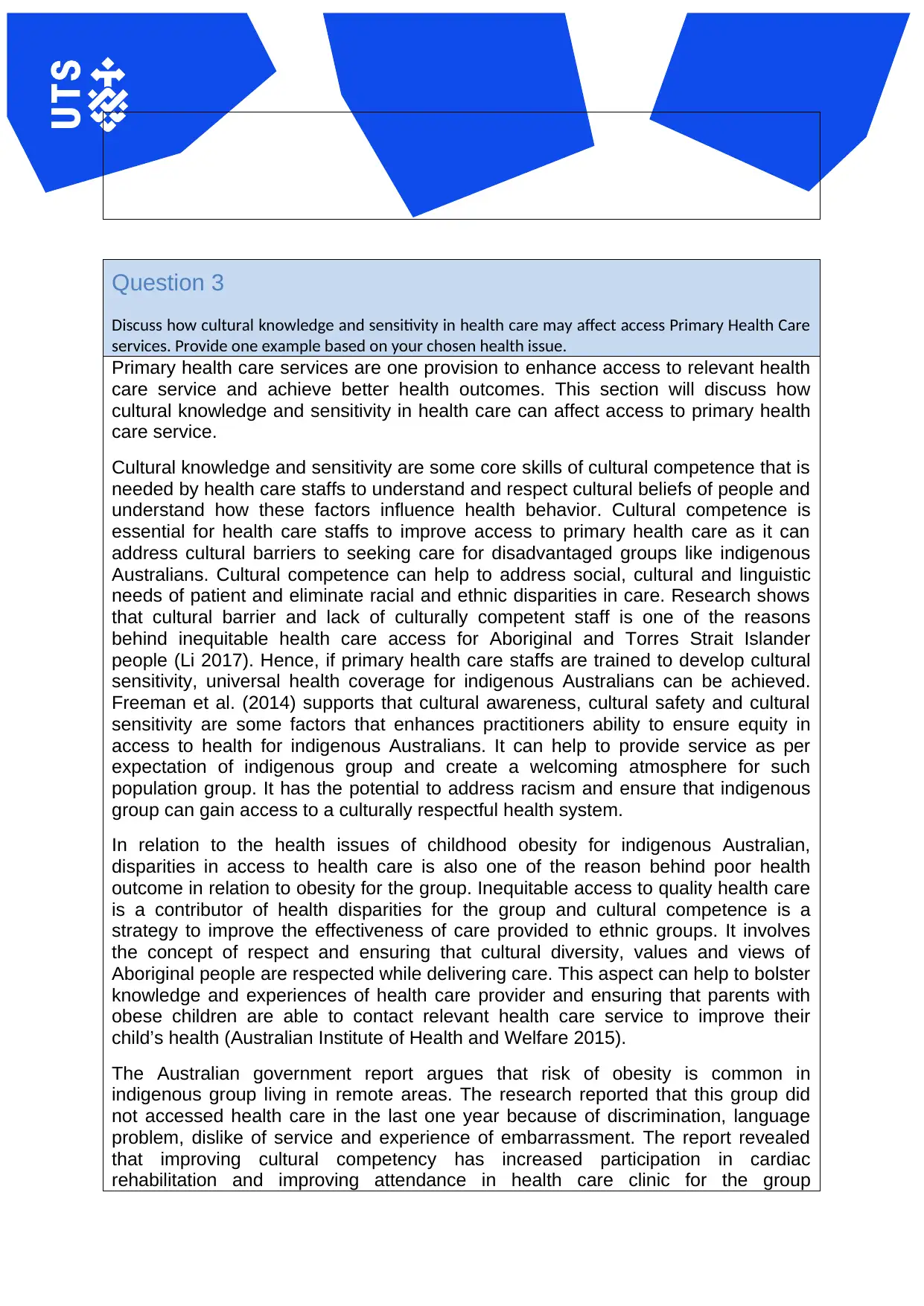
Question 3
Discuss how cultural knowledge and sensitivity in health care may affect access Primary Health Care
services. Provide one example based on your chosen health issue.
Primary health care services are one provision to enhance access to relevant health
care service and achieve better health outcomes. This section will discuss how
cultural knowledge and sensitivity in health care can affect access to primary health
care service.
Cultural knowledge and sensitivity are some core skills of cultural competence that is
needed by health care staffs to understand and respect cultural beliefs of people and
understand how these factors influence health behavior. Cultural competence is
essential for health care staffs to improve access to primary health care as it can
address cultural barriers to seeking care for disadvantaged groups like indigenous
Australians. Cultural competence can help to address social, cultural and linguistic
needs of patient and eliminate racial and ethnic disparities in care. Research shows
that cultural barrier and lack of culturally competent staff is one of the reasons
behind inequitable health care access for Aboriginal and Torres Strait Islander
people (Li 2017). Hence, if primary health care staffs are trained to develop cultural
sensitivity, universal health coverage for indigenous Australians can be achieved.
Freeman et al. (2014) supports that cultural awareness, cultural safety and cultural
sensitivity are some factors that enhances practitioners ability to ensure equity in
access to health for indigenous Australians. It can help to provide service as per
expectation of indigenous group and create a welcoming atmosphere for such
population group. It has the potential to address racism and ensure that indigenous
group can gain access to a culturally respectful health system.
In relation to the health issues of childhood obesity for indigenous Australian,
disparities in access to health care is also one of the reason behind poor health
outcome in relation to obesity for the group. Inequitable access to quality health care
is a contributor of health disparities for the group and cultural competence is a
strategy to improve the effectiveness of care provided to ethnic groups. It involves
the concept of respect and ensuring that cultural diversity, values and views of
Aboriginal people are respected while delivering care. This aspect can help to bolster
knowledge and experiences of health care provider and ensuring that parents with
obese children are able to contact relevant health care service to improve their
child’s health (Australian Institute of Health and Welfare 2015).
The Australian government report argues that risk of obesity is common in
indigenous group living in remote areas. The research reported that this group did
not accessed health care in the last one year because of discrimination, language
problem, dislike of service and experience of embarrassment. The report revealed
that improving cultural competency has increased participation in cardiac
rehabilitation and improving attendance in health care clinic for the group
Discuss how cultural knowledge and sensitivity in health care may affect access Primary Health Care
services. Provide one example based on your chosen health issue.
Primary health care services are one provision to enhance access to relevant health
care service and achieve better health outcomes. This section will discuss how
cultural knowledge and sensitivity in health care can affect access to primary health
care service.
Cultural knowledge and sensitivity are some core skills of cultural competence that is
needed by health care staffs to understand and respect cultural beliefs of people and
understand how these factors influence health behavior. Cultural competence is
essential for health care staffs to improve access to primary health care as it can
address cultural barriers to seeking care for disadvantaged groups like indigenous
Australians. Cultural competence can help to address social, cultural and linguistic
needs of patient and eliminate racial and ethnic disparities in care. Research shows
that cultural barrier and lack of culturally competent staff is one of the reasons
behind inequitable health care access for Aboriginal and Torres Strait Islander
people (Li 2017). Hence, if primary health care staffs are trained to develop cultural
sensitivity, universal health coverage for indigenous Australians can be achieved.
Freeman et al. (2014) supports that cultural awareness, cultural safety and cultural
sensitivity are some factors that enhances practitioners ability to ensure equity in
access to health for indigenous Australians. It can help to provide service as per
expectation of indigenous group and create a welcoming atmosphere for such
population group. It has the potential to address racism and ensure that indigenous
group can gain access to a culturally respectful health system.
In relation to the health issues of childhood obesity for indigenous Australian,
disparities in access to health care is also one of the reason behind poor health
outcome in relation to obesity for the group. Inequitable access to quality health care
is a contributor of health disparities for the group and cultural competence is a
strategy to improve the effectiveness of care provided to ethnic groups. It involves
the concept of respect and ensuring that cultural diversity, values and views of
Aboriginal people are respected while delivering care. This aspect can help to bolster
knowledge and experiences of health care provider and ensuring that parents with
obese children are able to contact relevant health care service to improve their
child’s health (Australian Institute of Health and Welfare 2015).
The Australian government report argues that risk of obesity is common in
indigenous group living in remote areas. The research reported that this group did
not accessed health care in the last one year because of discrimination, language
problem, dislike of service and experience of embarrassment. The report revealed
that improving cultural competency has increased participation in cardiac
rehabilitation and improving attendance in health care clinic for the group
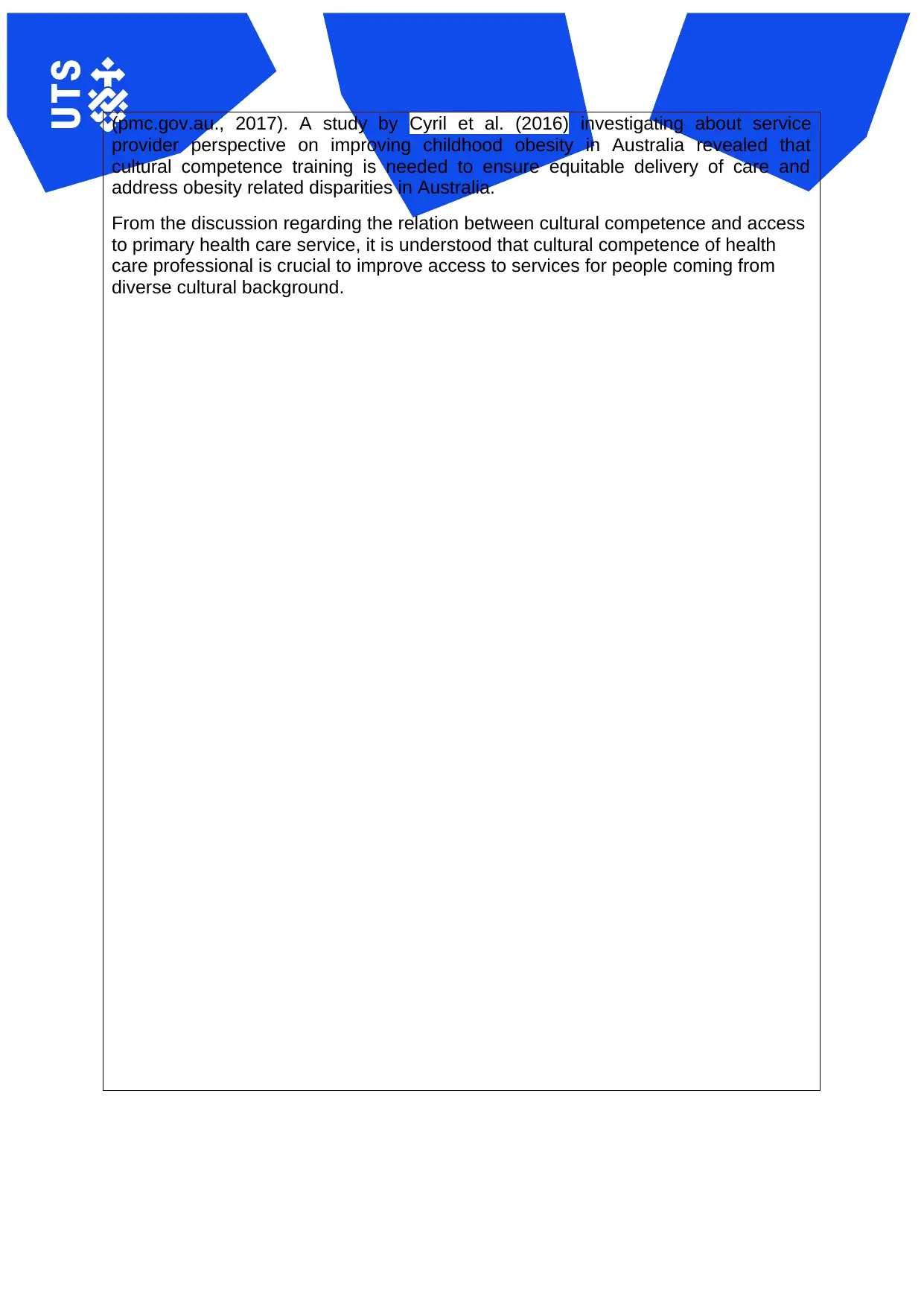
(pmc.gov.au., 2017). A study by Cyril et al. (2016) investigating about service
provider perspective on improving childhood obesity in Australia revealed that
cultural competence training is needed to ensure equitable delivery of care and
address obesity related disparities in Australia.
From the discussion regarding the relation between cultural competence and access
to primary health care service, it is understood that cultural competence of health
care professional is crucial to improve access to services for people coming from
diverse cultural background.
provider perspective on improving childhood obesity in Australia revealed that
cultural competence training is needed to ensure equitable delivery of care and
address obesity related disparities in Australia.
From the discussion regarding the relation between cultural competence and access
to primary health care service, it is understood that cultural competence of health
care professional is crucial to improve access to services for people coming from
diverse cultural background.
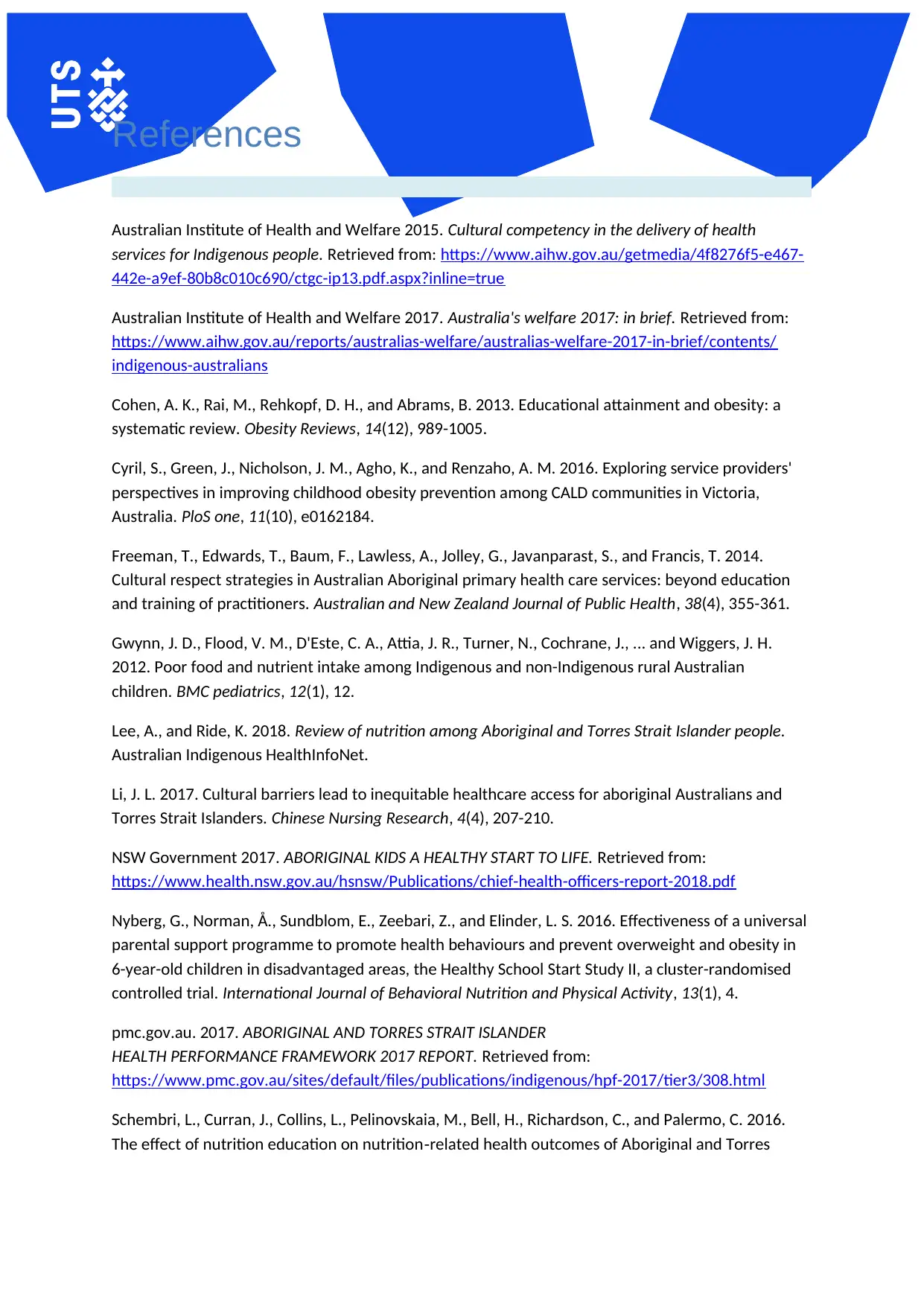
References
Australian Institute of Health and Welfare 2015. Cultural competency in the delivery of health
services for Indigenous people. Retrieved from: https://www.aihw.gov.au/getmedia/4f8276f5-e467-
442e-a9ef-80b8c010c690/ctgc-ip13.pdf.aspx?inline=true
Australian Institute of Health and Welfare 2017. Australia's welfare 2017: in brief. Retrieved from:
https://www.aihw.gov.au/reports/australias-welfare/australias-welfare-2017-in-brief/contents/
indigenous-australians
Cohen, A. K., Rai, M., Rehkopf, D. H., and Abrams, B. 2013. Educational attainment and obesity: a
systematic review. Obesity Reviews, 14(12), 989-1005.
Cyril, S., Green, J., Nicholson, J. M., Agho, K., and Renzaho, A. M. 2016. Exploring service providers'
perspectives in improving childhood obesity prevention among CALD communities in Victoria,
Australia. PloS one, 11(10), e0162184.
Freeman, T., Edwards, T., Baum, F., Lawless, A., Jolley, G., Javanparast, S., and Francis, T. 2014.
Cultural respect strategies in Australian Aboriginal primary health care services: beyond education
and training of practitioners. Australian and New Zealand Journal of Public Health, 38(4), 355-361.
Gwynn, J. D., Flood, V. M., D'Este, C. A., Attia, J. R., Turner, N., Cochrane, J., ... and Wiggers, J. H.
2012. Poor food and nutrient intake among Indigenous and non-Indigenous rural Australian
children. BMC pediatrics, 12(1), 12.
Lee, A., and Ride, K. 2018. Review of nutrition among Aboriginal and Torres Strait Islander people.
Australian Indigenous HealthInfoNet.
Li, J. L. 2017. Cultural barriers lead to inequitable healthcare access for aboriginal Australians and
Torres Strait Islanders. Chinese Nursing Research, 4(4), 207-210.
NSW Government 2017. ABORIGINAL KIDS A HEALTHY START TO LIFE. Retrieved from:
https://www.health.nsw.gov.au/hsnsw/Publications/chief-health-officers-report-2018.pdf
Nyberg, G., Norman, Å., Sundblom, E., Zeebari, Z., and Elinder, L. S. 2016. Effectiveness of a universal
parental support programme to promote health behaviours and prevent overweight and obesity in
6-year-old children in disadvantaged areas, the Healthy School Start Study II, a cluster-randomised
controlled trial. International Journal of Behavioral Nutrition and Physical Activity, 13(1), 4.
pmc.gov.au. 2017. ABORIGINAL AND TORRES STRAIT ISLANDER
HEALTH PERFORMANCE FRAMEWORK 2017 REPORT. Retrieved from:
https://www.pmc.gov.au/sites/default/files/publications/indigenous/hpf-2017/tier3/308.html
Schembri, L., Curran, J., Collins, L., Pelinovskaia, M., Bell, H., Richardson, C., and Palermo, C. 2016.
The effect of nutrition education on nutrition‐related health outcomes of Aboriginal and Torres
Australian Institute of Health and Welfare 2015. Cultural competency in the delivery of health
services for Indigenous people. Retrieved from: https://www.aihw.gov.au/getmedia/4f8276f5-e467-
442e-a9ef-80b8c010c690/ctgc-ip13.pdf.aspx?inline=true
Australian Institute of Health and Welfare 2017. Australia's welfare 2017: in brief. Retrieved from:
https://www.aihw.gov.au/reports/australias-welfare/australias-welfare-2017-in-brief/contents/
indigenous-australians
Cohen, A. K., Rai, M., Rehkopf, D. H., and Abrams, B. 2013. Educational attainment and obesity: a
systematic review. Obesity Reviews, 14(12), 989-1005.
Cyril, S., Green, J., Nicholson, J. M., Agho, K., and Renzaho, A. M. 2016. Exploring service providers'
perspectives in improving childhood obesity prevention among CALD communities in Victoria,
Australia. PloS one, 11(10), e0162184.
Freeman, T., Edwards, T., Baum, F., Lawless, A., Jolley, G., Javanparast, S., and Francis, T. 2014.
Cultural respect strategies in Australian Aboriginal primary health care services: beyond education
and training of practitioners. Australian and New Zealand Journal of Public Health, 38(4), 355-361.
Gwynn, J. D., Flood, V. M., D'Este, C. A., Attia, J. R., Turner, N., Cochrane, J., ... and Wiggers, J. H.
2012. Poor food and nutrient intake among Indigenous and non-Indigenous rural Australian
children. BMC pediatrics, 12(1), 12.
Lee, A., and Ride, K. 2018. Review of nutrition among Aboriginal and Torres Strait Islander people.
Australian Indigenous HealthInfoNet.
Li, J. L. 2017. Cultural barriers lead to inequitable healthcare access for aboriginal Australians and
Torres Strait Islanders. Chinese Nursing Research, 4(4), 207-210.
NSW Government 2017. ABORIGINAL KIDS A HEALTHY START TO LIFE. Retrieved from:
https://www.health.nsw.gov.au/hsnsw/Publications/chief-health-officers-report-2018.pdf
Nyberg, G., Norman, Å., Sundblom, E., Zeebari, Z., and Elinder, L. S. 2016. Effectiveness of a universal
parental support programme to promote health behaviours and prevent overweight and obesity in
6-year-old children in disadvantaged areas, the Healthy School Start Study II, a cluster-randomised
controlled trial. International Journal of Behavioral Nutrition and Physical Activity, 13(1), 4.
pmc.gov.au. 2017. ABORIGINAL AND TORRES STRAIT ISLANDER
HEALTH PERFORMANCE FRAMEWORK 2017 REPORT. Retrieved from:
https://www.pmc.gov.au/sites/default/files/publications/indigenous/hpf-2017/tier3/308.html
Schembri, L., Curran, J., Collins, L., Pelinovskaia, M., Bell, H., Richardson, C., and Palermo, C. 2016.
The effect of nutrition education on nutrition‐related health outcomes of Aboriginal and Torres
Paraphrase This Document
Need a fresh take? Get an instant paraphrase of this document with our AI Paraphraser

Strait Islander people: a systematic review. Australian and New Zealand journal of public
health, 40(S1), S42-S47.
Thurber, K. A., Joshy, G., Korda, R., Eades, S. J., Wade, V., Bambrick, H., ... and Banks, E. 2018.
Obesity and its association with sociodemographic factors, health behaviours and health status
among Aboriginal and non-Aboriginal adults in New South Wales, Australia. J Epidemiol Community
Health, 72(6), 491-498.
health, 40(S1), S42-S47.
Thurber, K. A., Joshy, G., Korda, R., Eades, S. J., Wade, V., Bambrick, H., ... and Banks, E. 2018.
Obesity and its association with sociodemographic factors, health behaviours and health status
among Aboriginal and non-Aboriginal adults in New South Wales, Australia. J Epidemiol Community
Health, 72(6), 491-498.
1 out of 8
Related Documents
Your All-in-One AI-Powered Toolkit for Academic Success.
+13062052269
info@desklib.com
Available 24*7 on WhatsApp / Email
![[object Object]](/_next/static/media/star-bottom.7253800d.svg)
Unlock your academic potential
© 2024 | Zucol Services PVT LTD | All rights reserved.





